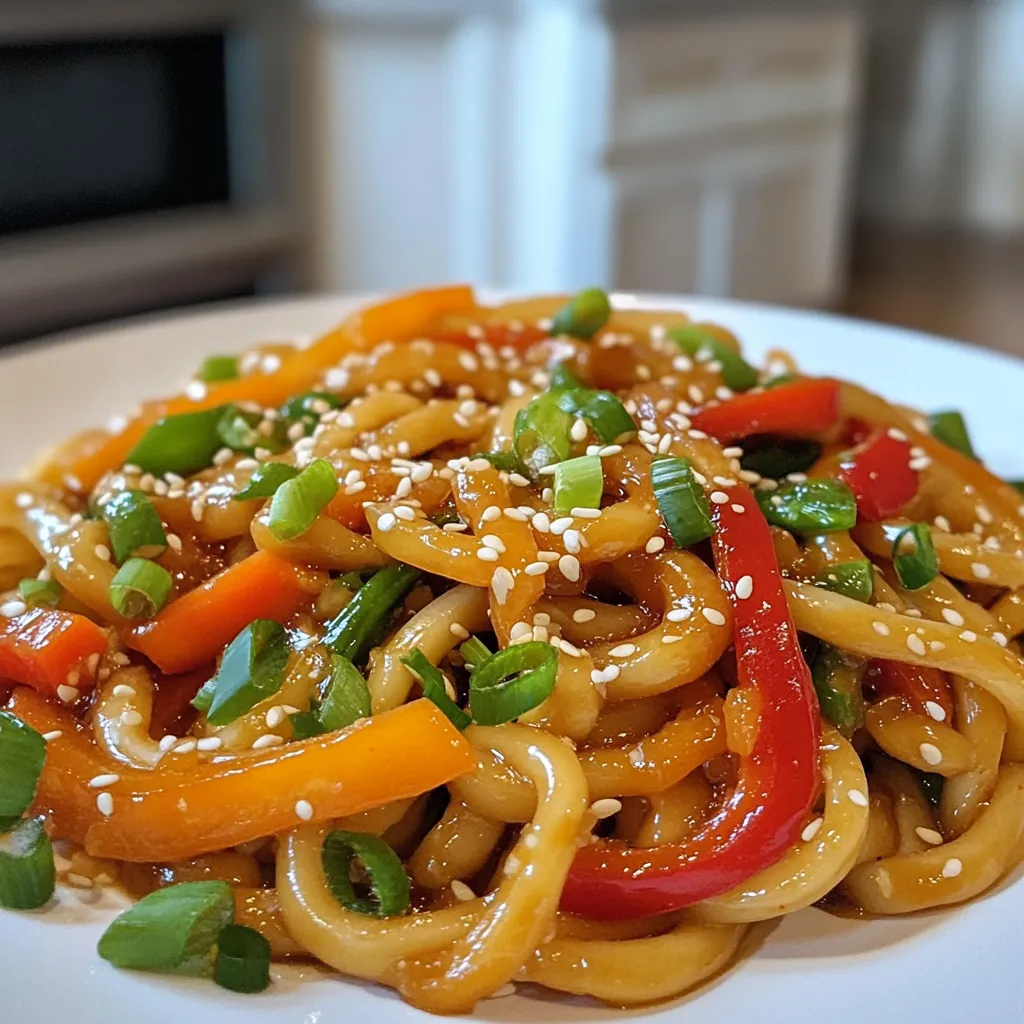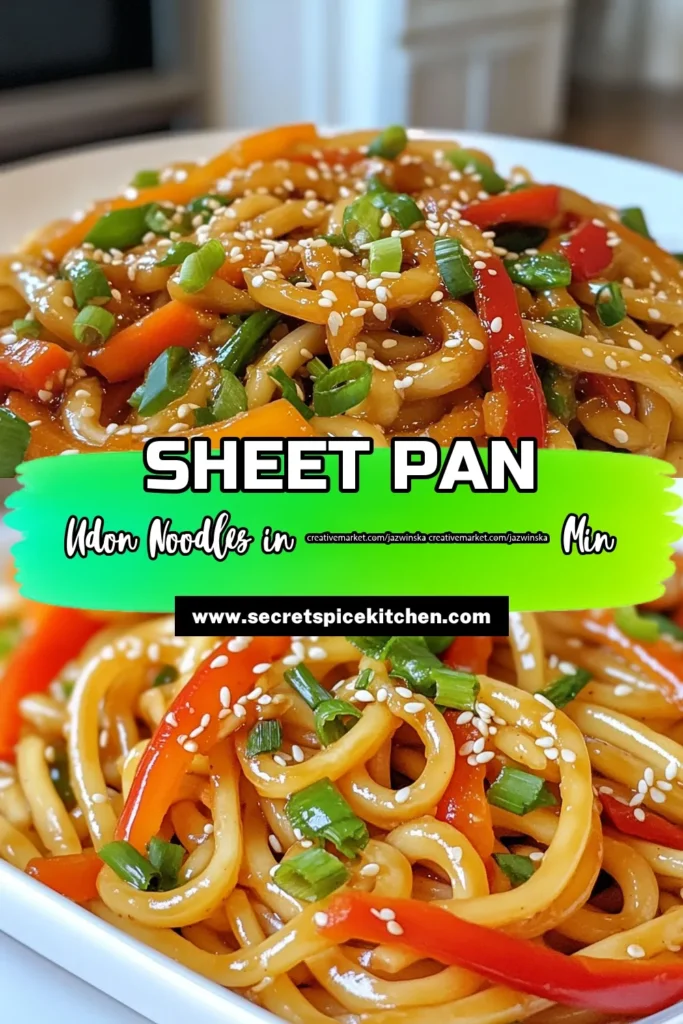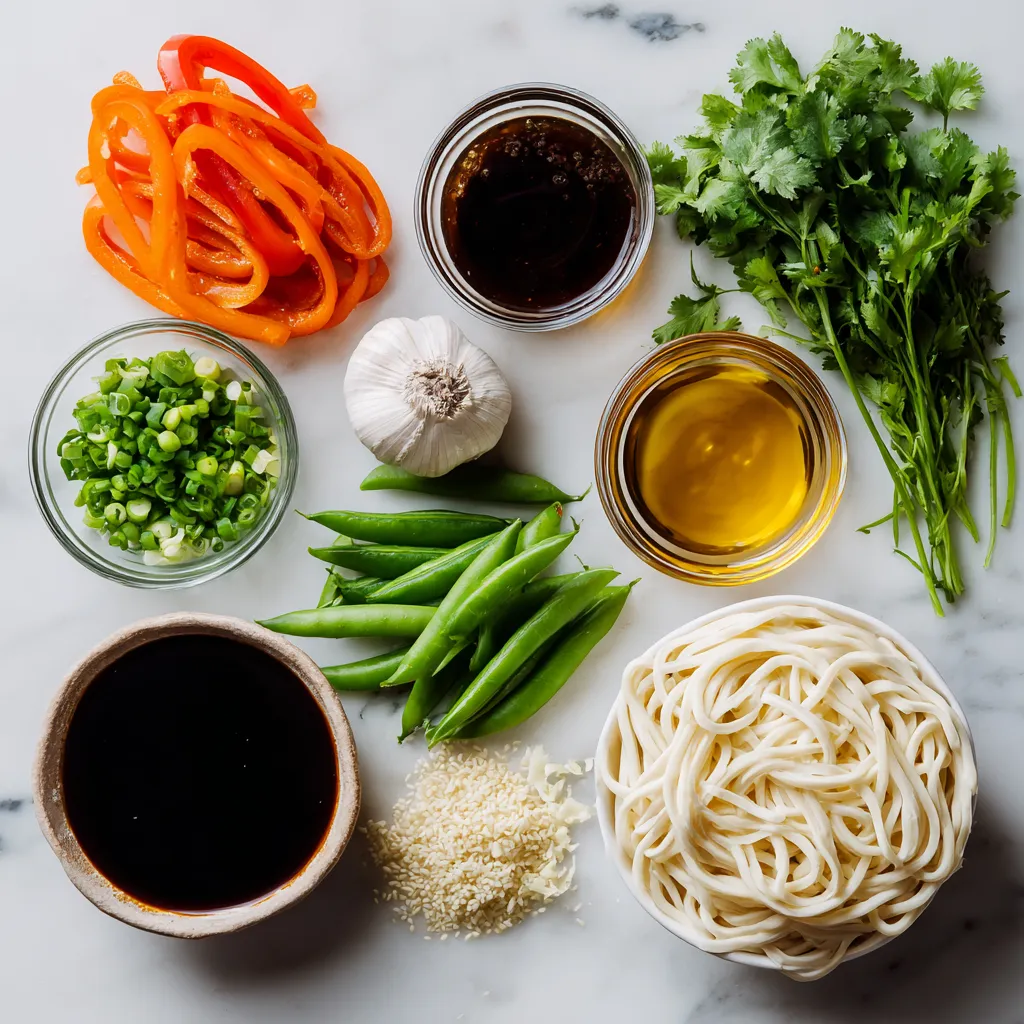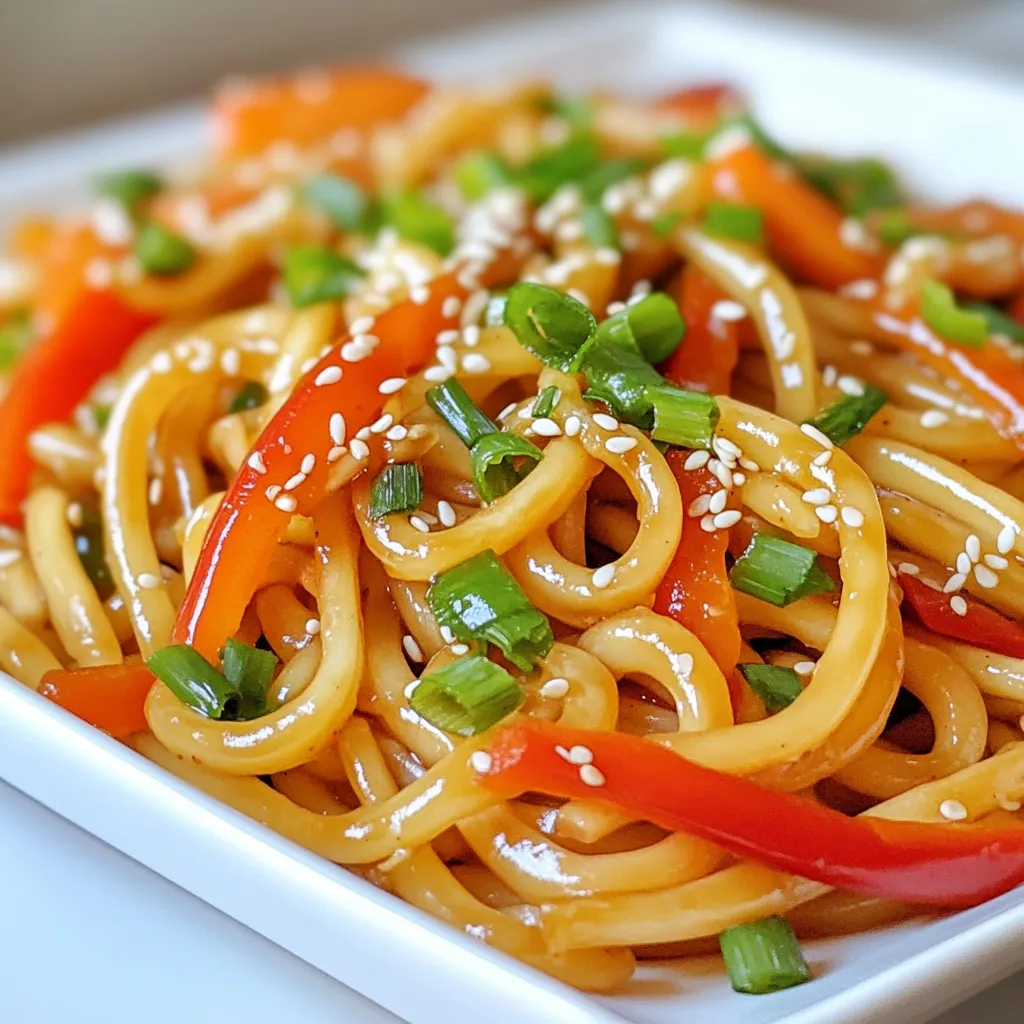WANT TO SAVE THIS RECIPE?
Looking for a quick and tasty dinner? Let me introduce you to Sheet Pan Soy Sauce Udon! This one-pan meal is packed with flavor, colorful veggies, and those delicious udon noodles you love. It’s not just easy to make; it’s also fun to personalize. In this post, I’ll share all the ingredients, step-by-step instructions, and clever tips to make your dish shine. Ready to dive into this savory delight?

Why I Love This Recipe
- Quick and Easy: This sheet pan recipe comes together in just 30 minutes, making it perfect for busy weeknights.
- Flavorful and Satisfying: The combination of soy sauce, sesame oil, and fresh vegetables creates a deliciously savory dish that’s sure to please.
- Versatile Ingredients: You can easily customize the vegetables or add proteins such as tofu or chicken to suit your taste.
- Minimal Cleanup: Cooking everything on a single sheet pan means less mess and more time to enjoy your meal!
Ingredients
Main Ingredients
– 12 oz udon noodles
– 2 tablespoons soy sauce
– 1 tablespoon oyster sauce (optional)
Vegetables
– 1 red bell pepper, sliced
– 1 cup sugar snap peas
– 1 medium carrot, julienned
– 5 green onions, chopped
Aromatics and Garnish
– 2 cloves garlic, minced
– 1 teaspoon fresh ginger, grated
– Sesame seeds for garnish
– Fresh cilantro for garnish (optional)
I love the bright and fresh flavors in this recipe. The udon noodles are thick and chewy, perfect for soaking up the sauces. The soy sauce gives a rich flavor, while the oyster sauce adds depth if you choose to use it.
For the veggies, I pick a red bell pepper for its sweetness. Sugar snap peas add a nice crunch, while the carrot adds vibrant color and sweetness. Green onions give the dish a nice bite.
Don’t skip the garlic and ginger! They add a warm and spicy touch. Finally, top with sesame seeds and cilantro for a pop of flavor and color. These ingredients come together to create a tasty meal you can enjoy any night of the week!

Step-by-Step Instructions
Preparing Noodles and Vegetables
– Preheat the oven to 425°F (220°C). This step is key for a great roast.
– Cook udon noodles according to package instructions. Make sure they are al dente. Drain and set aside. You want them just right, not mushy.
Roasting Vegetables
– On a large sheet pan, combine sliced red bell pepper, sugar snap peas, and julienned carrot.
– Drizzle with 1 tablespoon of sesame oil and toss them well. This adds flavor and helps with roasting.
– Roast the vegetables in the oven for 10 minutes. Stir halfway through so they cook evenly. They should be tender and slightly caramelized when done.
Mixing and Final Roasting
– In a large bowl, whisk together soy sauce, oyster sauce (if using), and the remaining tablespoon of sesame oil. Add minced garlic and grated ginger. Mix well to combine.
– After the vegetables roast, add the cooked udon noodles to the sheet pan. Pour the soy sauce mixture over everything. Toss to coat all the noodles and veggies.
– Return the sheet pan to the oven and roast for an additional 5-7 minutes. This warms everything up and lets the noodles soak up the sauce.
Now you’re ready to enjoy a delicious and easy meal!
Tips & Tricks
Cooking Tips
To ensure the udon noodles are cooked al dente, follow the package instructions closely. Start boiling the water well before adding the noodles. Check them a minute or two before the time is up. They should be firm yet tender.
For roasting vegetables, timing is key. Roast the red bell pepper, sugar snap peas, and carrots for about 10 minutes. Stir halfway to avoid uneven cooking. They should be slightly tender and caramelized for the best flavor.
Garnishing Suggestions
For a beautiful finish, sprinkle sesame seeds and chopped green onions on top. The seeds add a nice crunch. If you like, add fresh cilantro for color and freshness. Mix them together or layer them for an appealing look.
Best Serving Practices
You can serve the dish straight from the sheet pan for a casual vibe. If you prefer, transfer it to a large serving dish to impress guests. Make sure to garnish with extra sesame seeds and cilantro. This makes the dish pop with color and taste. Enjoy it warm for the best experience!
Pro Tips
- Cook Noodles Al Dente: For the best texture, cook the udon noodles just until they’re al dente. They will continue to cook slightly when you roast them with the vegetables.
- Customize Your Veggies: Feel free to add any of your favorite vegetables to the sheet pan, such as broccoli, mushrooms, or zucchini, to enhance the flavor and nutrition.
- Make It Spicy: If you enjoy a bit of heat, add some red pepper flakes or sliced fresh chili peppers to the soy sauce mixture before tossing everything together.
- Garnish Wisely: For added flavor, consider garnishing with toasted sesame oil drizzled on top just before serving, alongside the sesame seeds and cilantro.

Variations
Alternative Sauces
You can swap the oyster sauce for a vegetarian option. Use a vegetarian oyster sauce to keep the umami flavor. You can also mix soy sauce with hoisin sauce for a sweet twist. If you want something lighter, try a splash of rice vinegar. All these swaps will keep your dish tasty and full of flavor.
Protein Additions
Adding protein can make your meal heartier. Chicken, shrimp, or tofu work great in this dish. For chicken, use thin slices to cook quickly and blend well. Shrimp cooks fast, so add it just before the final roasting. If you prefer tofu, press and cube it first. Toss it in with the veggies for a lovely texture.
Vegetable Substitutions
Feel free to customize your veggies. Broccoli, snap peas, or bell peppers add color and crunch. Zucchini or bok choy can also fit in nicely. Try using frozen mixed vegetables if you’re short on fresh ones. They save time and still taste great when cooked properly.
Storage Info
Refrigeration Guidelines
After enjoying your Sheet Pan Soy Sauce Udon, you may have leftovers. To store them, let the dish cool down. Then, place it in an airtight container. This keeps your meal fresh. Store it in the fridge. Enjoy it within three to four days for the best taste.
Freezing Options
If you want to keep your udon for a longer time, freezing is great. First, let the dish cool completely. Next, pack it in a freezer-safe container. You can also use freezer bags. Make sure to remove excess air. This helps prevent freezer burn. When you’re ready to eat, thaw it overnight in the fridge. Reheat it in a pan over low heat. Add a splash of water or soy sauce for moisture.
Shelf Life
Leftovers from your Sheet Pan Soy Sauce Udon will last in the fridge for about three to four days. If frozen, they can last up to two months. After this time, the quality may drop. Always check for off smells or changes before eating. Keeping track of the dates helps ensure safe eating.
FAQs
Can I use another type of noodle?
Yes, you can swap udon noodles for other types! Here are some options:
– Soba noodles: These are made from buckwheat and have a nutty flavor.
– Rice noodles: They are gluten-free and very light.
– Spaghetti: A simple choice if you want a familiar taste.
Using different noodles can change the dish’s texture and flavor. Just be sure to cook them according to package instructions.
Is this dish gluten-free?
To make this dish gluten-free, choose gluten-free soy sauce. Look for tamari or coconut aminos as a substitute. You can also use rice noodles instead of udon. This way, you keep the great taste while catering to gluten restrictions.
How can I make this dish spicier?
If you want to add heat, try these tips:
– Add red pepper flakes: A little goes a long way!
– Use sriracha: Mix it into the sauce for a spicy kick.
– Slice fresh chili peppers: Mix them with the vegetables before roasting.
These ideas will give your dish a nice heat boost while keeping the flavors balanced. Enjoy your cooking!
This article covered a delicious udon noodle dish, from key ingredients to easy steps. You learned how to prepare fresh vegetables and use savory sauces. I shared tips for cooking and serving, ensuring the best taste and texture. With variations for sauces and proteins, you can customize it to your liking. Remember proper storage to keep leftovers fresh. Enjoy exploring this dish and making it your ow
Sheet Pan Soy Sauce Udon Bliss
A delicious and easy sheet pan recipe featuring udon noodles and colorful vegetables, all tossed in a savory soy sauce mixture.
Prep Time 15 minutes mins
Cook Time 15 minutes mins
Total Time 30 minutes mins
Course Main Course
Cuisine Asian
Servings 4
Calories 400 kcal
- 12 oz udon noodles
- 2 tablespoons soy sauce
- 1 tablespoon oyster sauce (optional; can be substituted with vegetarian oyster sauce)
- 2 tablespoons sesame oil
- 1 red bell pepper sliced
- 1 cup sugar snap peas
- 1 medium carrot, julienned
- 5 pieces green onions, chopped
- 2 cloves garlic, minced
- 1 teaspoon fresh ginger, grated
- to taste sesame seeds for garnish
- to taste fresh cilantro for garnish (optional)
Preheat your oven to 425°F (220°C).
Cook the udon noodles according to package instructions, then drain and set aside.
On a large sheet pan, combine the sliced red bell pepper, sugar snap peas, and julienned carrot. Drizzle with 1 tablespoon of sesame oil and toss to coat.
Roast the vegetables in the oven for 10 minutes, stirring halfway, until they are slightly tender and beginning to caramelize.
In a large bowl, whisk together the soy sauce, oyster sauce (if using), and the remaining 1 tablespoon of sesame oil. Add the minced garlic and grated ginger, mixing well.
After the vegetables have roasted, add the cooked udon noodles to the sheet pan. Pour the soy sauce mixture over the noodles and vegetables, tossing everything to combine evenly.
Return the sheet pan to the oven and roast for an additional 5-7 minutes, until everything is heated through and the noodles have absorbed some of the sauce.
Remove from the oven, sprinkle with sesame seeds and chopped green onions. Add fresh cilantro if desired.
Serve directly from the sheet pan or transfer to a large serving dish. Garnish with additional sesame seeds and cilantro for a pop of color. Enjoy warm!
Keyword sheet pan, soy sauce, udon, vegetables
WANT TO SAVE THIS RECIPE?





